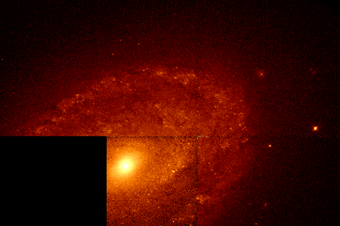Astronomy:NGC 1436
| NGC 1436 | |
|---|---|
 NGC 1436 / NGC 1437 (NASA/ESA HST) | |
| Observation data (J2000.0 epoch) | |
| Constellation | Eridanus |
| Right ascension | 03h 43m 37.08s [1] |
| Declination | −35° 51′ 10.90″ [1] |
| Redshift | 0.004627 [1] |
| Helio radial velocity | 1387 ± 8 km/s [1] |
| Distance | 58 Mly[1] |
| Apparent magnitude (V) | 11.7 [2] |
| Apparent magnitude (B) | 12.5 [2] |
| Characteristics | |
| Type | SBab [2] |
| Apparent size (V) | 3.1 x 2.0 [2] |
| Other designations | |
| NGC 1437, PGC 13687, MCG -6-9-25, ESO 358-58, FCC 290 | |
NGC 1436 (also called NGC 1437) is a barred spiral galaxy approximately 58 million light-years away from Earth in the constellation of Eridanus.[1][2] It is a member of the Fornax I cluster.[3]
Observational history
This galaxy was entered twice in the New General Catalogue, first as NGC 1436 and after that as NGC 1437.[3][4] It was discovered by John Herschel on January 9, 1836, who described it as "very bright, and evidently a globular cluster".[3] It later received designation NGC 1436.[3] It was also observed by Scottish astronomer James Dunlop with his 9" reflector at Parramatta, who described it as "a pretty large faint round nebula, about 3.5' diameter, gradual slight condensation to the centre, very faint at the margin".[3]
John Herschel observed this object again on November 28, 1837, assumed it was new and measured an accurate position. It later received second designation in the New General Catalogue (NGC 1437) because of that.[3]
Until recently this galaxy was often called NGC 1437, but in recent references it is being called NGC 1436 more and more frequently.[4]
See also
References
- ↑ 1.0 1.1 1.2 1.3 1.4 1.5 "NASA/IPAC Extragalactic Database". http://ned.ipac.caltech.edu/cgi-bin/objsearch?objname=NGC+1436.
- ↑ 2.0 2.1 2.2 2.3 2.4 "Revised NGC Data for NGC 1436". http://spider.seds.org/ngc/revngcic.cgi?NGC1436.
- ↑ 3.0 3.1 3.2 3.3 3.4 3.5 "Data for NGC 1436". http://www.astronomy-mall.com/Adventures.In.Deep.Space/NGC%201000%20-%201999%20(11-30-17).htm.
- ↑ 4.0 4.1 "New General Catalog Objects: NGC 1400 - 1449" (in en-US). http://cseligman.com/text/atlas/ngc14.htm#1436.
External links
- NGC 1436 on WikiSky: DSS2, SDSS, GALEX, IRAS, Hydrogen α, X-Ray, Astrophoto, Sky Map, Articles and images
 |

